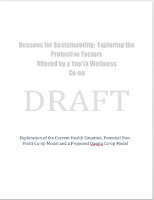By Stephen
Penner, 2nd year MDP student
The summer
was spent reflecting on the question of development: respectful development,
requested development. When to act, what to do, and how to do development. It was spent struggling with the larger
question of “what is the place for a non-Indigenous person to work in
Indigenous communities” and the smaller challenge of appropriateness of
addressing requests made by Yup’ik community members. The short answer to the
broader question, is that while on placement for the program, one must act in
accordance to the program and use the lessons learned in the MDP to facilitate
respectful approaches and answers.
 |
| Community general store in Alaska |
My first
request was to create a business plan for a Yup’ik community based commercial
enterprise. I called upon my learnings from the course in Indigenous Business
Planning and my group work project from the MDP Capstone course. The plan was
to create an Anchorage based food distribution company as a division of the
commercial enterprise. Allowing the
community to take advantage of the preferential treatment that minority owned
businesses receive when bidding on contracts. I spent two days in Anchorage
with the principal, meeting with potential partners and entities that were
going to be critical in executing the plan.
 |
| Fish processing |
The second
request was to build an “un-corruptible” intra-community wellness agency to act
in support of the Qunasvik initiative whose focus is suicide reduction. The objective was to create a Yup’ik based
agency that could act, support and build protective factors in the 5 communities
that the Qunasvik was active. I knew the development challenge would be to
understand the lived experience of the Yup’ik and translate that into the
model.
Choosing a
Co-op model, I created an Indigenous structure that included important cultural
features to the Yup’ik that needed to written into the by-laws. Based on the
Qasgig (the traditional meeting place of the Yup’ik) I outlined the reasons,
rationale and starting structure of a not-for-profit (501(c)) model. Reviewing the plans with a Co-op developer at
the University of Alaska Anchorage, I received his blessing that this model as
executable. I was able to complete the proposal prior to my departure. A review of the funding structures and
building an understanding of successful prevention models allowed a path to be
suggested as a way to restore agency to Yup’ik communities.
One summer,
two models, one unforgettable experience and many lessons later, I am left with
the ongoing question that I started with.
The only answer that I have is that when asked to deliver a project,
bring the best of what you understand of the community and the best of what you
can offer as a “gift” to the community. You may use such opportunities to
facilitate “the good life.”


No comments:
Post a Comment